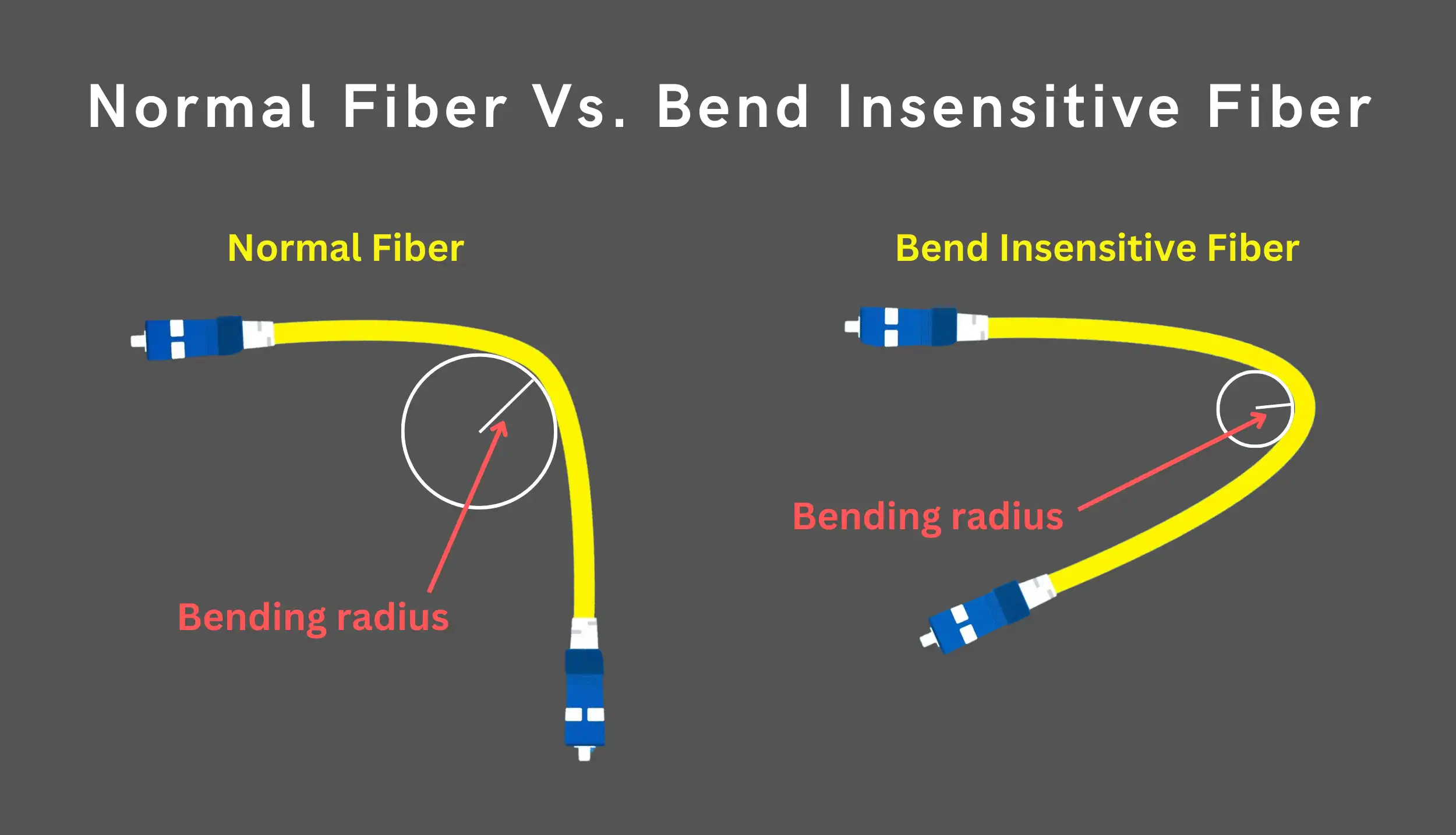In the fast-paced world of digital connectivity, where networks must adapt to complex environments and soaring data demands, bend-insensitive fiber (BIF) emerges as a game-changer. Designed to maintain signal integrity even when sharply bent, these advanced optical fibers enable reliable, high-speed communication in tight spaces and challenging installations. From urban FTTH (Fiber to the Home) deployments to compact data centers, bend-insensitive fiber is redefining network design. This comprehensive guide explores the technology behind BIF, its advantages, applications, and installation best practices, while showcasing how Dekam Fiber’s innovative solutions empower robust connectivity. Let’s dive into the world of bend-insensitive fiber.
What Is Bend-Insensitive Fiber?
Bend-insensitive fiber is a specialized type of optical fiber engineered to minimize signal loss when bent at tight radii, a common challenge in traditional fibers. Standard single-mode fibers (SMF), adhering to ITU-T G.652 standards, suffer significant attenuation (e.g., >0.5 dB) when bent below a 30 mm radius, limiting their use in confined spaces. BIF, such as ITU-T G.657-compliant fibers (e.g., G.657.A1, A2, B3), reduces this loss to as low as 0.1 dB at a 7.5 mm radius, making it ideal for dense urban installations or intricate indoor setups.

The secret lies in BIF’s design: a modified refractive index profile with a trench or ring of low-index material around the core, which traps light more effectively during bends. For example, G.657.B3 fibers can handle 5 mm bends with losses below 0.15 dB at 1550 nm, compared to 1 dB for G.652 fibers. This resilience supports high-speed applications, such as 100 Gbps over 40 km, without compromising signal quality. Dekam Fiber’s BendFlex series, compliant with G.657 standards, delivers these benefits, enabling seamless connectivity in challenging environments.
As of 2025, the fiber optic market is booming, with a projected CAGR of 10.2% through 2032, driven by 5G, IoT, and smart city initiatives. BIF adoption is accelerating, with G.657 fibers accounting for 35% of global FTTH deployments, according to industry reports. Dekam Fiber aligns with these trends, offering BIF cables that integrate AI-driven diagnostics and eco-friendly materials, reducing installation costs by 20% and supporting sustainable network growth.
Key Characteristics of Bend-Insensitive Fiber
Bend-insensitive fibers are defined by several critical features:
- Low Bend Loss: G.657.A1 fibers maintain <0.25 dB loss at a 10 mm radius, while G.657.B3 achieves <0.15 dB at 5 mm, compared to >1 dB for G.652 fibers.
- Utangamano: Fully compatible with standard SMF (G.652), ensuring seamless integration into existing networks. Dekam’s cables support hybrid deployments without adapters.
- High Bandwidth: Supports 400 Gbps over 40 km with DWDM, ideal for high-capacity telecom and data center applications.
- Kudumu: Enhanced cladding withstands mechanical stress, with tensile strengths up to 70 N, suitable for rugged environments.
- Compact Design: Enables tighter cable routing, reducing space requirements by 30% in high-density installations.
These characteristics make BIF versatile for modern networks, aligning with 2025 trends like ultra-dense 5G small cell deployments and AI-optimized data centers requiring flexible cabling.
Advantages of Bend-Insensitive Fiber
BIF offers significant benefits over traditional fibers:
- Flexibility in Installation: Tight bends (e.g., 7.5 mm) allow routing around corners, through conduits, or in compact enclosures, reducing installation time by 25%. For example, a 1 km FTTH drop can be installed in 2 hours versus 3 for standard fibers.
- Reduced Signal Loss: Low bend losses (<0.1 dB at 10 mm) ensure signal integrity, supporting 100G over 80 km without additional amplifiers, cutting costs by 15%.
- Cost Efficiency: Minimizes the need for specialized bend protection, saving ~$0.10/m in materials. Dekam’s pre-terminated BIF cables further reduce labor costs.
- Kuegemea: Enhanced durability withstands environmental stressors (e.g., -40°C to 85°C), reducing maintenance by 20% over 10 years.
- Future-Proofing: Supports emerging standards like 800G Ethernet, aligning with 2025’s demand for ultra-high-speed networks.
Dekam Fiber’s cables leverage these advantages, offering G.657.A2 and B3 options with UV-resistant jackets for outdoor durability, ensuring 99.999% uptime in critical applications.
Comparing Bend-Insensitive Fiber to Standard Fiber
To highlight BIF’s superiority, here’s a detailed comparison with standard single-mode fiber (G.652):
| Kipengele | Bend-Insensitive Fiber (G.657) | Standard Fiber (G.652) |
|---|---|---|
| Kima cha chini cha Bend Radius | 5-10 mm (e.g., 0.1 dB loss at 7.5 mm) | 30 mm (e.g., 1 dB loss at 15 mm) |
| Kupunguza (1550 nm) | 0.18-0.2 dB/km | 0.2 dB/km |
| Max Speed/Distance | 400 Gbps over 40 km | 400 Gbps over 40 km |
| Maombi | FTTH, data centers, 5G small cells | Long-haul telecom, traditional networks |
| Installation Complexity | Low; flexible routing in tight spaces | High; requires careful bend management |
| Cost per Meter | $0.65-$0.80 | $0.50-$0.60 |
| Kudumu | High; withstands tight bends, vibrations | Moderate; prone to loss under stress |
| Faida | Low loss, flexible, future-proof | Cost-effective, widely compatible |
| Hasara | Slightly higher cost | High bend loss, limited flexibility |
This table underscores BIF’s edge in flexibility and reliability, particularly for dense deployments. Dekam Fiber’s BIF solutions balance cost and performance, making them ideal for 2025’s high-density network demands.
Applications of Bend-Insensitive Fiber
BIF’s unique properties enable diverse applications:
- FTTH Deployments: Facilitates tight routing in apartments or offices, supporting 1-10 Gbps for 8K streaming and VR. Dekam’scables reduce FTTH installation time by 30%.
- Data Centers: Enables high-density cabling in racks, supporting 400G interconnects with <1 ms latency. Dekam’s compact BIF cables save 25% space.
- 5G Small Cells: Supports dense urban deployments with bends around poles or buildings, delivering 100 Gbps backhaul. Dekam’s rugged BIF withstands outdoor conditions.
- Smart Cities: Powers IoT networks with flexible cabling for sensors and cameras. Dekam’s solutions support 10,000+ devices per km².
- Industrial and Medical: Ensures reliable signal transmission in tight machinery or imaging systems. Dekam’s BIF cables operate in -40°C to 85°C environments.
In 2025, BIF’s role in AI-driven networks is growing, with low-latency requirements (<1 ms) for autonomous systems. Dekam Fiber’s BIF cables, with integrated diagnostics, support these cutting-edge applications.
Installation Best Practices for Bend-Insensitive Fiber
Proper installation maximizes BIF’s performance:
- Cable Preparation: Strip 1.5-2 cm of the jacket using a Dekam stripper, exposing the 125 μm core. Clean with $6 alcohol pads to prevent contamination, taking 3-5 minutes per cable.
- Splicing: Use a Dekam fusion splicer for <0.05 dB loss splices, or mechanical splices for quick fixes (0.15 dB). Protect with heat-shrink sleeves, shrinking in 25 seconds (10-15 minutes per splice).
- Routing: Route BIF through tight spaces, maintaining a 7.5-10 mm bend radius. Use Dekam’s cable ties and trays to secure fibers, ensuring compliance with G.657 standards (5-10 minutes).
- Termination: Connect to SC/APC or LC/UPC adapters in termination boxes, achieving <0.2 dB loss per connection. Dekam’s pre-terminated BIF cables reduce this to 5 minutes per port.
- Testing: Verify with a Dekam OTDR, targeting <0.1 dB bend loss and <0.2 dB/km attenuation. Log results for ITU-T compliance, taking 10-15 minutes.
Dekam’s AI-enhanced splicers and testing tools streamline installation, cutting time by 20% and ensuring first-pass success rates of 99.8%.
Challenges in Using Bend-Insensitive Fiber
Despite its advantages, BIF faces challenges:
- Higher Cost: BIF cables cost $0.65-$0.80/m versus $0.50/m for G.652. Dekam’s bulk discounts and leasing options reduce costs by 15%.
- Compatibility Issues: Splicing BIF with older G.652 fibers may increase losses (e.g., 0.3 dB). Dekam’s hybrid splicers ensure seamless integration.
- Installation Errors: Overbending beyond rated limits (e.g., <5 mm for G.657.B3) risks micro-cracks. Dekam’s training teaches proper handling.
- Equipment Needs: High-precision splicers and cleavers are required. Dekam’s affordable kits lower barriers for small teams.
- Market Availability: Supply chain constraints in 2025 may limit BIF stock. Dekam’s local manufacturing ensures consistent supply.
Emerging challenges include adapting BIF for ultra-high-density 800G networks and ensuring eco-compliance. Dekam addresses these with recyclable materials and scalable designs.
Conclusion: Embrace Flexibility with Dekam Fiber
Bend-insensitive fiber redefines network design, offering unmatched flexibility, low loss, and reliability for modern connectivity. Whether navigating tight urban spaces or powering AI-driven networks, trust Dekam Fiber to provide cutting-edge solutions for 2025 and beyond. Build resilient, high-speed networks with the power of bend-insensitive fiber.




